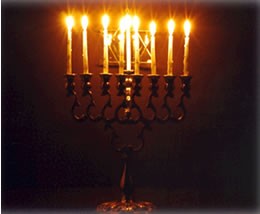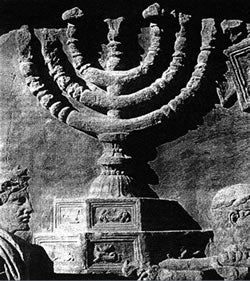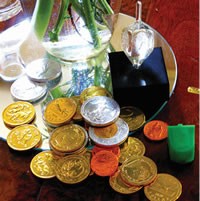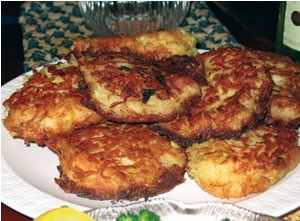Hanukkah FAQ’s
What is Hanukkah?
 Hanukkah, the Festival of Lights, celebrates the victory of the Maccabees over the Syrians, the rededication of the Holy Temple in Jerusalem, and the miracle that took place in the Temple.
Hanukkah, the Festival of Lights, celebrates the victory of the Maccabees over the Syrians, the rededication of the Holy Temple in Jerusalem, and the miracle that took place in the Temple.
The year was 170 BC, and there was a Greek ruler in Syria named Antiochus. When his army conquered the land of Judea, Antiochus ordered the people of Israel to reject their God, their religion, their customs and beliefs, and to worship the Greek gods. To make matters worse, his armies went into the Holy Temple of Jerusalem, defiled the menorah, ruined the altar, and erected statues of their own gods.
Some of the Jews did as they were told, however the majority of them refused. One of these men, Judah the Maccabee, his four brothers, and others who were not willing to give up their customs and beliefs, formed an army, calling themselves the Maccabees. After three years of fighting many battles, the Maccabees succeeded in driving the Syrians out of Israel and reclaimed the Holy Temple in Jerusalem.
 Upon their victory, they cleaned the Temple, and removed all the Greek statues. On the 25th day of the month of Kislev, their work was complete and the Temple was rededicated. All they had left to do was light the eternal light. Once lit, the oil lamp was to remain lit forever, never to be extinguished, symbolizing God’s eternal presence. They searched for oil, but only found enough to light the menorah for one day. Then the miracle of Hanukkah occurred and the oil that was only supposed to last for one day illuminated the Temple for eight days. Today we celebrate Hanukkah for eight days and we light a menorah to commemorate this miracle. The word Hanukkah means rededication.
Upon their victory, they cleaned the Temple, and removed all the Greek statues. On the 25th day of the month of Kislev, their work was complete and the Temple was rededicated. All they had left to do was light the eternal light. Once lit, the oil lamp was to remain lit forever, never to be extinguished, symbolizing God’s eternal presence. They searched for oil, but only found enough to light the menorah for one day. Then the miracle of Hanukkah occurred and the oil that was only supposed to last for one day illuminated the Temple for eight days. Today we celebrate Hanukkah for eight days and we light a menorah to commemorate this miracle. The word Hanukkah means rededication.
Why are There so Many Different Ways to Spell Hanukkah? (Or Chanukah? Or Hannukah? Or…..)
There is no correct or incorrect way to spell Hanukkah, since it is just the transliteration of the Hebrew word. However, some spellings are more popular than others. The most popular spelling is Hanukkah, followed by Chanukah. Alternative spellings include Hanukah, Hannukah, and Chanukkah. No matter which version you choose, Hannukah always spells fun!
What Is the Difference Between a Menorah and a Hanukkiah?
 The menorah is one of the oldest symbols of the Jewish people. Many say that it symbolizes the burning bush that Moses saw on Mount Sinai. Others believe it’s a symbol of the Jews’ mission to be "a light unto the nations." The menorah, which has seven branches, originally burned olive oil, not candles, and was used in rituals in the tabernacle and later the Holy Temple in Jerusalem. The kohanim (Jewish priests) lit the menorah every evening and cleaned it out every morning, replacing the wicks and putting fresh olive oil into the cups.
The menorah is one of the oldest symbols of the Jewish people. Many say that it symbolizes the burning bush that Moses saw on Mount Sinai. Others believe it’s a symbol of the Jews’ mission to be "a light unto the nations." The menorah, which has seven branches, originally burned olive oil, not candles, and was used in rituals in the tabernacle and later the Holy Temple in Jerusalem. The kohanim (Jewish priests) lit the menorah every evening and cleaned it out every morning, replacing the wicks and putting fresh olive oil into the cups.
Since the destruction of the Temple, the menorah has had no formal role in Jewish prayer services. However, a lamp called the ner tamid (the eternal flame), can be found in most synagogues today to commemorate the original menorah.
A nine-candle menorah, called a hanukkiah, and patterned after the original menorah, is used to celebrate Hanukkah. One candle is lit on the first night, two candles are lit on the second night, and so on. The ninth candle, the shamash, is a "helper candle" that is used to light the others. The candle holder for the shamash is usually distinguished in some way from the other eight candle holders. Traditionally, it is placed higher than the others, often in the center, with four candles on each side. The candles are placed in the hanukkiah from right to left and are lit from left to right. The celebration lasts for eight nights, with a new candle lit each evening.
Many Hanukkah candles are blue and white, the colors of the Israeli flag, however, they can be any color, shape, or size. Electric menorahs are great to display in a window, however, the lights used to fulfill the mitzvah are supposed to be real flames fueled by wax or oil – like the flames in the Holy Temple. Even though all Hanukkah menorahs are hanukkiahs, people still say, “It’s time to light the menorah.”
Why Does Hanukkah Begin on a Different Day Every Year?
Although Hanukkah occurs on a different day every year in the Gregorian calendar (also known as the Western calendar), it occurs on the same day every year in the Jewish calendar. Hanukkah ALWAYS begins on the 25th day of Kislev - the ninth month of the Jewish calendar. Since the Jewish calendar is lunar based, it has a different number of days than the Western calendar, which is based on a solar year of 365 days. There are about 29.5 days in each lunar month, so there is roughly an 11 day difference between 12 lunar months and one solar year. The length of the Jewish calendar year varies in a repeating 19-year cycle of 235 lunar months, with a month added according to defined rules every two or three years. Some years, Hanukkah occurs in late November, and some years it falls closer to Christmas at the end of December.
What Is a Dreidel and How do you Play the Dreidel Game?
 After the menorah, the dreidel is probably the most recognized symbol of Hanukkah. It is a four-sided spinning top with a Hebrew letter on each side. The letters are: Nun, Gimmel, Hay, and Shin, which stand for the Hebrew phrase: "Nes Gadol Haya Sham.” When translated this means, “A great miracle happened there.”
After the menorah, the dreidel is probably the most recognized symbol of Hanukkah. It is a four-sided spinning top with a Hebrew letter on each side. The letters are: Nun, Gimmel, Hay, and Shin, which stand for the Hebrew phrase: "Nes Gadol Haya Sham.” When translated this means, “A great miracle happened there.”
Players spin the top and guess which Hebrew letter will be shown when the dreidel stops spinning. A similar game was popular during the rule of Antiochus, when the Jews were not free to openly practice their religion. When they gathered to study the Torah, they would bring a top with them. If soldiers appeared, they would quickly hide their books and pretend to be gambling.
After the State of Israel was founded in 1948, the Hebrew letters were changed for dreidels used in Israel. They became: Nun, Gimmel, Hay, and Pey. These letters stand for the Hebrew phrase, "Nes Gadol Haya Po," which means, “A great miracle happened here.”
The miracle refers to the miracle of the Hanukkah oil, which lasted for eight days instead of one.
Jewish children around the world love to play the dreidel game! At the beginning of each round, every player puts a piece of candy into “the pot” and take turns spinning the dreidel, with certain meanings assigned to each of the Hebrew letters as follows:
- Nun means "nichts," or "nothing" in Yiddish. If the dreidel lands with a nun facing up the spinner does nothing.
- Gimmel means "ganz," which is Yiddish for "everything." If the dreidel lands with the gimmel facing up, the spinner gets everything in the pot.
- Hey means "halb," which means "half" in Yiddish. If the dreidel lands with a hey facing up, the spinner gets half of the pot.
- Shin means "shtel," which is Yiddish for "put in," and pey means "pay." If the dreidel lands with either a shin or a pey facing up, the player adds a piece of candy to the pot.
The game proceeds with each player taking a turn until one player has all the candy or tokens, or the players decide to end the game. At any point that a player has no candy or tokens, they are out of the game.
Dreidels vary greatly in size, cost, and even what is used to make them. There are beautiful metal and glass dreidels and there are even edible chocolate dreidels. Dreidels make wonderful gifts for both children and adults.
What Is Hanukkah Gelt?
 Gelt is the Yiddish term for money. For decades, coins were a common gift given from parents to children on Hanukkah. Today, kids receive elaborate gifts for Hanukkah, so the coins given are usually made from chocolate. Hanukkah gelt is traditionally round pieces of chocolate wrapped in gold foil, made to look like coins. American candy companies first introduced gold and silver-wrapped chocolate gelt in the 1920’s. Today, the majority of the chocolate gelt sold and eaten in the United States is produced in Israel.
Gelt is the Yiddish term for money. For decades, coins were a common gift given from parents to children on Hanukkah. Today, kids receive elaborate gifts for Hanukkah, so the coins given are usually made from chocolate. Hanukkah gelt is traditionally round pieces of chocolate wrapped in gold foil, made to look like coins. American candy companies first introduced gold and silver-wrapped chocolate gelt in the 1920’s. Today, the majority of the chocolate gelt sold and eaten in the United States is produced in Israel.
If you would like to make your own, here is a simple recipe that makes three to four dozen coins:
Homemade Chocolate Gelt
- 1 cup high-quality dark or milk chocolate chips
- 1 teaspoon canola oil
- 1/2 teaspoon vanilla extract
- Gold and silver foil wrappers (optional)
Line two baking sheets with parchment paper. In a double boiler over medium-low heat, melt chocolate chips, oil, and vanilla extract, stirring constantly until chips are completely melted, about 5 minutes. The mixture should be thick and malleable. Turn off heat, but do not remove double boiler from burner. Working quickly, pinch off a small amount of the chocolate mixture (about 1/4 teaspoon) and roll it into a ball. Set it on the lined baking sheet, and repeat until you have a few rows completed. Flatten each ball into 1-inch “coins.” Repeat this process until all chocolate is used up. If chocolate hardens during the process, add a tiny bit more oil, and heat over low heat until it is malleable again. Place baking trays in fridge, and allow gelt to harden for at least 1 hour. Once chilled, wrap in foil and distribute to your favorite children.
What Are Traditional Hanukkah Foods?
 Donuts and latkes (also known as potato pancakes) are traditional Hanukkah foods. The significance of these foods isn’t the potato or dough; it is the oil they are fried in. The oil commemorates the miracle of Hanukkah, when one day’s worth of oil burned for eight days.
Donuts and latkes (also known as potato pancakes) are traditional Hanukkah foods. The significance of these foods isn’t the potato or dough; it is the oil they are fried in. The oil commemorates the miracle of Hanukkah, when one day’s worth of oil burned for eight days.
Potato pancakes are made from shredded potatoes mixed with eggs, fried in oil, and served with applesauce or sour cream. However, for the more health-conscious Hanukkah cook, non-traditional latkes can also be made from spinach, shredded zucchini, or sweet potatoes.
Hanukkah Treats Around the World
Around the world, Jews have different traditional foods for Hanukkah. Sufganiyot are Israeli jelly doughnuts. After frying, sufganiyot are usually coated in confectioner’s sugar. Libyan and Moroccan Jews enjoy a delicacy called “sfenz” (or sfenj). These are fried doughnuts with an exotic twist – their ingredients include orange peel, finely chopped almonds, and orange-flower water, and they are dipped in syrup made of sugar, vanilla, and lemon juice. Greek Jews eat “burmuelos,” deep-fried fritters also served with a syrup made of honey, sugar and water.
Below is a very easy recipe for potato latkes:
Potato Latkes
- 2 onions
- 3 medium to large eggs
- 5 potatoes
- 1/2 cup all purpose flour
- 1 teaspoon salt
- 1/4 teaspoon pepper
- Oil for frying - canola oil is usually best
Peel potatoes and cut into large cubes. Peel onions and quarter them. Puree the potatoes and onions in a blender or food processor until smooth. Place your blended mixture in a mixing bowl and add already beaten eggs. Add your desired amount of salt and pepper and enough flour to make a thick but creamy mixture.
Fill a large frying pan with about one inch of oil and heat on medium high. Add one quarter cup of your latke mix into the pan. Use caution to avoid being splattered by hot oil. Flatten the latke as it cooks so that it will cook thoroughly. Fry on each side until it is golden brown. When done, remove the latke from your pan and drain on paper towels. This recipe yields about twenty potato latkes.
What Are Popular Hanukkah Gifts?
Anything that will put a smile on the face of a friend or loved one would make a great Hanukkah present. However, if you’re looking specifically for a Judaica gift there are excellent choices. A chai, a Star of David, a menorah necklace or a hamsa incorporate a gift with a Jewish theme or symbol. A beautiful, traditional Hanukkah menorah is always a welcome present; although a modern menorah might be better for your hip friends.

